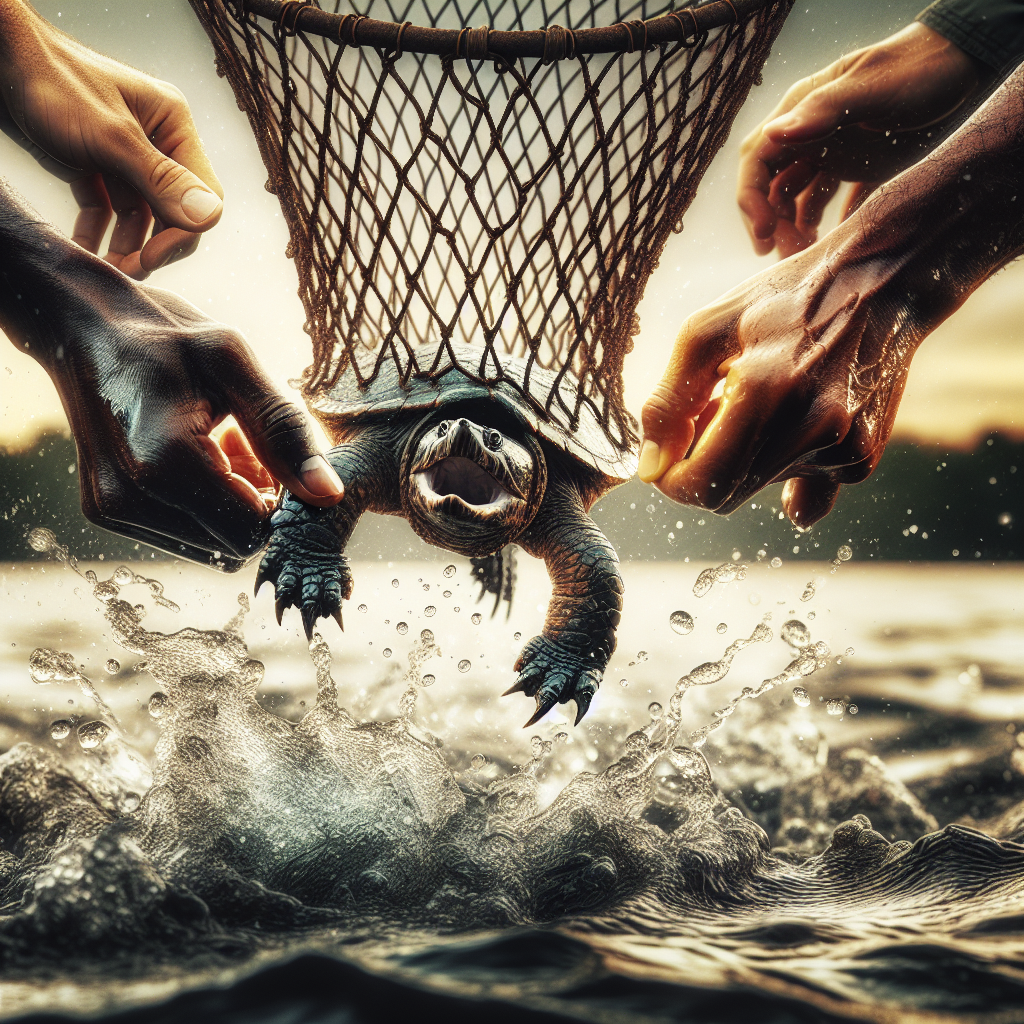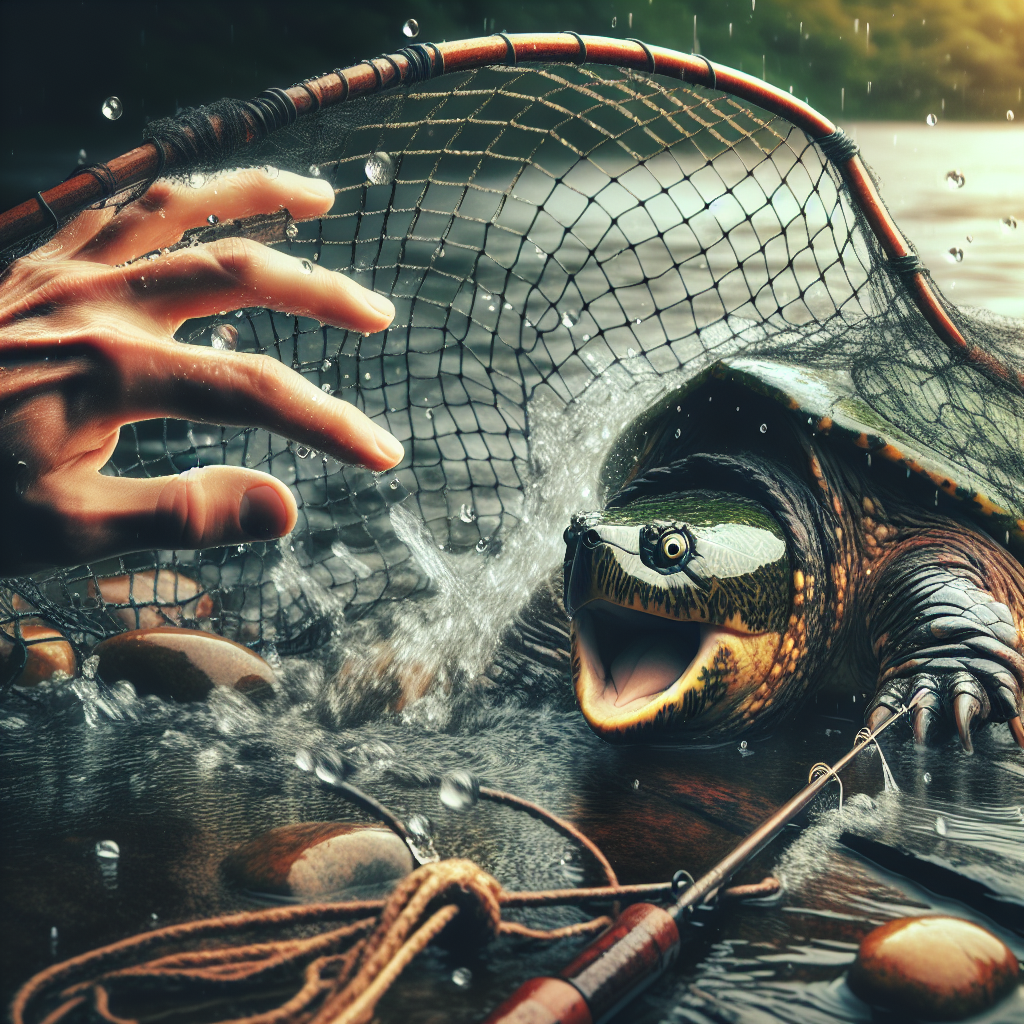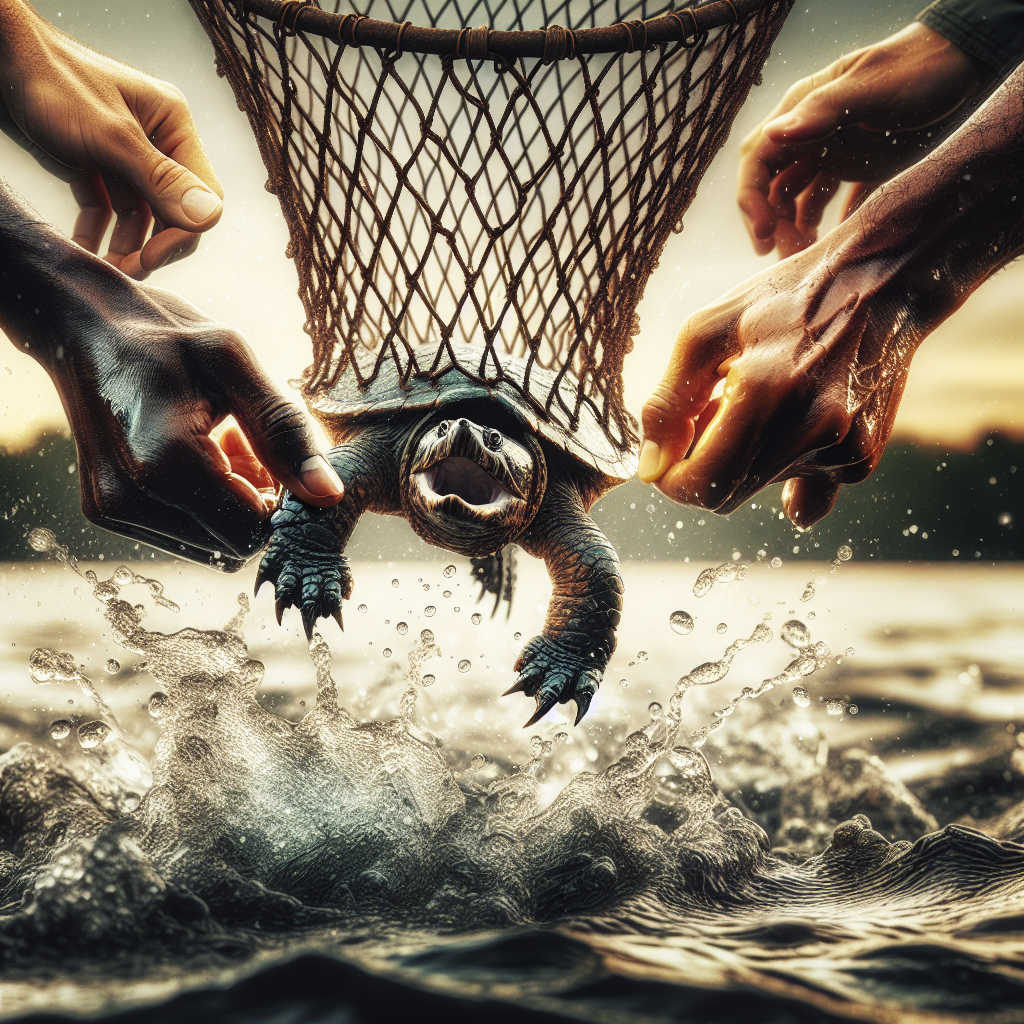So you’ve found yourself in the presence of a snapping turtle and you’re wondering, “How do I catch it?” Don’t worry, you’re in the right place! In this article, we’ll uncover some useful tips and techniques that will help you safely catch a snapping turtle. Whether you’re an animal enthusiast or simply trying to guide one out of harm’s way, we’ve got you covered. Get ready to embark on an exciting adventure and learn how to catch a snapping turtle like a pro!
Preparing for Snapping Turtle Capture
Researching snapping turtles
Before attempting to catch a snapping turtle, it is important to gather information about these unique creatures. Snapping turtles are known for their aggressive nature and powerful jaws, which makes capturing them a challenging task. By researching snapping turtle behavior, habitat preferences, and capture techniques, you can increase your chances of a safe and successful capture.
Understanding snapping turtle behavior
Snapping turtles are primarily aquatic creatures that inhabit freshwater bodies such as rivers, lakes, and ponds. They are opportunistic feeders and have a diverse diet that includes fish, amphibians, insects, and even small mammals. Understanding their behavior will help you anticipate their movements and choose effective capture methods accordingly.
Safety precautions
When dealing with snapping turtles, it is crucial to prioritize your safety and the welfare of the turtle. Snapping turtles have long necks and sharp beaks that can cause serious harm if mishandled. It is important to wear protective gear such as heavy-duty gloves and boots to minimize the risk of injury. Additionally, always approach snapping turtles with caution and avoid provoking them unnecessarily.
Gathering Equipment
Necessary equipment
To capture a snapping turtle, there are some essential tools you will need. These include a sturdy, heavy-duty trap designed specifically for snapping turtles, a long-handled net, a strong fishing line, hooks, and a pair of heavy-duty gloves. These tools will assist you in safely capturing and handling the turtle.
Optional equipment
While not absolutely necessary, there are some optional equipment items that can make the capture process easier. These include a snorkel and mask for snorkeling or diving captures, a spotting scope or binoculars to aid in locating turtles from a distance, and a GoPro or waterproof camera to document your captures. These optional items can enhance your experience and allow you to observe the turtles more closely.

Identifying Suitable Locations
Preferred habitats for snapping turtles
Snapping turtles prefer shallow, muddy or sandy bottoms in freshwater bodies such as swamps, lakes, and slow-moving rivers. They are often found near submerged structures like fallen logs or vegetation, as these provide them with shelter and ambush points for capturing prey. Understanding their preferred habitats will help you identify suitable locations for capture.
Identifying potential locations
To identify potential locations for snapping turtle capture, consider the characteristics mentioned earlier. Look for bodies of water with muddy or sandy bottoms, ample vegetation, and submerged structures. Additionally, keep an eye out for areas where you have previously seen snapping turtles or where they are known to be spotted. These areas are more likely to yield successful captures.
Setting Traps
Selecting the right trap type
There are various trap types available for capturing snapping turtles, including cage traps and hoop nets. Cage traps are typically preferred as they provide a secure enclosure for the turtle without causing harm. When selecting a trap, ensure it is of appropriate size to hold the turtle comfortably and has a sturdy construction to withstand the turtle’s strength.
Baiting the trap
Snapping turtles are attracted to a variety of food items, including fish, meat, and even vegetables. Baiting the trap with a suitable bait will increase the chances of luring in a turtle. Common bait options include fish guts, chicken liver, or even live fish. Ensure the bait is securely attached within the trap to prevent the turtle from escaping with it.
Placing the trap in water
When setting the trap, it is crucial to place it in the water. Snapping turtles are primarily aquatic and spend most of their time submerged. Position the trap in an area where turtles are known to be active, such as near submerged structures or along their known movement paths. Ensure the trap is securely anchored to prevent it from being moved or flipped by the turtle’s efforts to escape.
Monitoring and maintenance
Once the trap is set, it is important to regularly monitor it to ensure the captured turtle is promptly removed. Check the trap multiple times a day to minimize stress on the trapped turtle and prevent potential harm. Additionally, ensure the trap is well-maintained and in working condition, replacing any damaged or worn-out parts as necessary.

Using Hand Grabbing
Understanding hand grabbing method
Hand grabbing, also known as noodling, involves physically capturing the snapping turtle without the use of any tools or traps. This method requires a certain level of expertise and courage, as it involves directly handling the turtle and recognizing its behavior to avoid injury.
Approaching the turtle safely
When hand grabbing a snapping turtle, it is essential to approach it safely to minimize the risk of injury. Approach the turtle from behind and firmly grip its shell near the base of the tail. Avoid grabbing the turtle by its legs or head, as they can reach around and bite you with their long necks. Maintain a secure grip while handling the turtle to prevent it from escaping or causing harm.
Proper turtle handling techniques
When handling a captured snapping turtle, it is important to be gentle and cautious. Support the turtle’s body weight with both hands while avoiding any unnecessary pressure on its limbs or shell. Avoid dangling or swinging the turtle, as sudden movements can cause stress and potential injury. If the turtle becomes agitated or aggressive, slowly and calmly release your grip and allow it to retreat into the water.
Using Fishing Techniques
Understanding fishing method
Fishing for snapping turtles involves using fishing gear, such as a strong fishing line and hooks, to capture the turtle. This method requires patience and persistence, as it may take time for the turtle to bite on the bait.
Selecting appropriate fishing gear
To fish for snapping turtles, you will need a strong fishing line capable of withstanding the turtle’s strength. A heavy-duty fishing rod or handline is recommended, along with large-sized hooks to securely hold the turtle once it takes the bait. Ensure that your fishing gear is in good condition and properly tied to prevent any accidents or escapes.
Bait selection and techniques
When fishing for snapping turtles, selecting the right bait is crucial. Snapping turtles are known to be attracted to a wide variety of baits, including fish, chicken, or even pieces of raw meat. Choose a bait option that is readily available and securely attach it to the hook. Cast your line into the water and wait patiently for the turtle to take the bait. Avoid excessive movement or noise that may scare off the turtle.
Patience and persistence
Fishing for snapping turtles can be a waiting game, and patience is key. Turtles can take a significant amount of time to approach and take the bait, so it is important to remain calm and persistent. Keep a watchful eye on your fishing line and be prepared to reel it in as soon as you feel any significant movement. The process may require multiple attempts, but with time and perseverance, you may succeed in catching a snapping turtle.
Snorkeling or Diving
Preparation and safety measures
Snorkeling or diving to capture snapping turtles offers a unique and immersive experience but requires specific preparation and safety measures. Before attempting snorkeling or diving captures, ensure you are a competent swimmer and have proper training in snorkeling or diving techniques. Familiarize yourself with any local regulations or restrictions regarding snorkeling or diving in the area you plan to capture the turtle.
Equipment needed for snorkeling or diving
To capture a snapping turtle underwater, you will need snorkeling or diving equipment. This includes a snorkel or scuba mask, fins, wetsuit or drysuit depending on water temperature, and weight belts or buoyancy compensators for proper buoyancy control. Additionally, carry a mesh bag to safely store the captured turtle during your underwater encounter.
Locating and capturing the turtle underwater
When snorkeling or diving to capture a snapping turtle, it is important to scan the water surface and observe the turtle’s movements before approaching it. Snapping turtles are known for their ability to quickly retreat into the water, so approach them cautiously but confidently. Once within reach, gently grab the shell near the base of the tail, ensuring a firm grip to prevent the turtle from escaping. Safely secure the captured turtle in your mesh bag and carefully return to the surface.
Calling for Professional Help
When to contact wildlife professionals
While capturing a snapping turtle on your own can be an exciting adventure, there may be situations where it is best to seek the assistance of wildlife professionals. If you encounter a particularly large or aggressive turtle that you are unable to handle safely, or if you are unsure about local regulations or permits, it is advisable to contact professionals who have expertise in handling such situations.
Finding experienced turtle handlers
When searching for wildlife professionals with experience in capturing and handling snapping turtles, consider contacting local wildlife rehabilitation centers, turtle rescue organizations, or wildlife conservation agencies. These organizations often have personnel trained in handling snapping turtles and can provide expert guidance and assistance.
Guidelines for safe handling
If you decide to call for professional help, it is still important to ensure safe handling of the snapping turtle. Communicate clearly with the professionals about your concerns and ask for guidance on handling techniques if you wish to be involved. Observe their techniques closely and learn from their expertise to expand your knowledge of proper turtle handling.
Legal Considerations
Checking local regulations
Before embarking on snapping turtle capture, it is essential to thoroughly research and understand the local and state regulations regarding the capture and handling of these turtles. Snapping turtles are protected species in many areas due to concerns about their population decline. Familiarize yourself with any restrictions or permit requirements to ensure proper compliance with the law.
Obtaining necessary permits
If capturing snapping turtles requires a permit in your area, it is important to obtain the necessary permits before engaging in any capture activities. Contact your local wildlife agency or permit-issuing authority to inquire about the specific permits required and the application process. Compliance with permit requirements demonstrates a commitment to responsible wildlife handling and conservation.
Responsibility towards the welfare of turtles
While capturing a snapping turtle may be a thrilling experience, it is essential to prioritize the welfare and well-being of the turtles. Remember that these creatures play an important role in their ecosystem, and their populations need to be conserved. Always handle the turtles with care, minimize stress, and release them back into their natural habitat as soon as possible after capture. Respect and responsibility towards these magnificent creatures ensure their survival for future generations to enjoy.
Educating Others
Teaching about snapping turtles
One of the most significant contributions you can make towards snapping turtle conservation is to educate others about these remarkable creatures. Share your knowledge and experiences with friends, family, and fellow nature enthusiasts. Teach them about the snapping turtle’s behavior, habitat requirements, and the importance of conserving their populations.
Promoting turtle conservation
Take an active role in promoting turtle conservation efforts within your community. Support local organizations that work towards the protection and preservation of snapping turtles and their habitats. Participate in volunteering opportunities, donate funds, or get involved in community awareness campaigns. By spreading the message of turtle conservation, you can inspire others to appreciate these unique animals and take action to protect them.
Sharing knowledge and experiences
Lastly, share your own experiences of snapping turtle capture responsibly. Use platforms such as social media, blogs, or local newsletters to share educational content and stories about your encounters with snapping turtles. Emphasize the importance of responsible capture techniques, legal compliance, and the preservation of turtle populations. Engage in constructive discussions with fellow nature enthusiasts to foster a greater understanding and appreciation for snapping turtles and their conservation needs.
By following the guidelines outlined in this comprehensive article, you will be well-prepared and equipped to safely capture snapping turtles while promoting their conservation and well-being. Approach this endeavor with respect and responsibility, and enjoy the enriching experiences that come with studying and interacting with these magnificent creatures.
